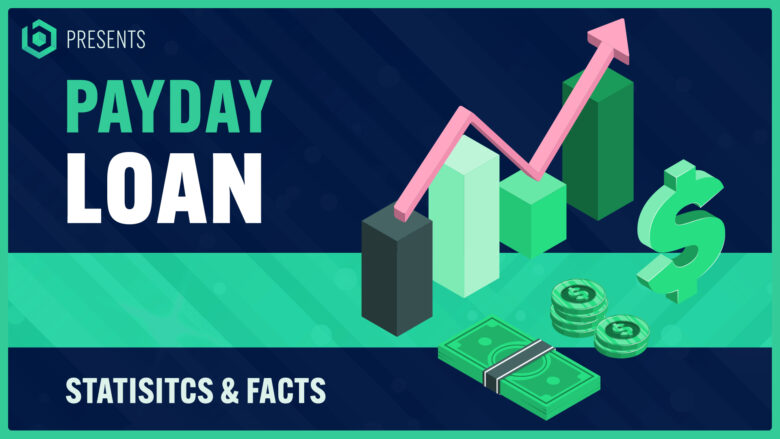Are you grappling with the fast-paced, high-interest world of payday loans? A startling reality is that 12 million Americans utilize this short-term financial solution annually. This comprehensive article will demystify the statistics and facts surrounding payday loans, helping you make more informed decisions about your financial future.
Ready to dive in? Let’s crunch those numbers!
- 12 million Americans utilize payday loans annually, drawn by their speedy approval process and minimal borrowing requirements.
- Payday loans have an average term of two weeks, with one in five borrowers failing to repay their loans.
- Certain demographics, such as recent immigrants, undereducated individuals, and lower – income individuals, are more likely to use payday loans due to limited access to traditional banking services and immediate financial needs.
- The global market value of payday loans is projected to reach $42.6 billion by 2028 with a compound annual growth rate (CAGR) of 4.1%.
Understanding Payday Loans
Payday loans offer immediate funds to cover unexpected or emergency expenses and are typically due on the borrower’s next payday. These high-interest loans serve as a short-term financing solution, often geared toward underbanked individuals looking for quick cash.
They differ from traditional personal loans by having significantly higher interest rates and short repayment periods – typically 2 weeks or whenever the borrower receives his next paycheck.
While these loans can appear beneficial at first glance, they may lead to a cycle of debt if not managed properly. Despite their risks, an estimated 12 million Americans turn to payday loans each year, drawn by their speedy approval process and minimal borrowing requirements.
The Current State of Payday Loans in America

Payday loans in America are experiencing a surge in popularity, with millions of Americans relying on these high-interest short-term loans to meet their financial needs.
General Payday Lending Statistics
The payday lending industry is a significant aspect of American finance. Here is a detailed look at this industry in tabular format:
| Statistical Aspect | Details |
|---|---|
| Average Term of Payday Loan | The average term for a payday loan is about two weeks. |
| Loan Defaults | One in five borrowers generally fail to repay their payday loans. |
| Repeat Borrowing | Almost 80 percent of borrowers tracked over ten months were found to have rolled over or reborrowed payday loans within 30 days. |
| Total People Using Payday Loans | An estimated 12 million Americans resort to payday loans every year. |
| Physical Presence of Lenders | Payday loan lenders run storefronts in 32 states. |
| State with Highest Payday Loan APR | Idaho has the highest average payday loan APR in the nation at 652 percent. |
| Cost in States with Fewer Consumer Protections | Payday loans cost four times more in states with fewer consumer protections. |
| Installment Loan Defaults | More than half of borrowers who secured installment loans from online lenders defaulted on their balance. |
These findings offer a glimpse into the payday lending landscape and highlight the prominent features and trends of this industry.
Payday Loan Demographics
In the United States, specific demographics are more likely to use payday loans, including recent immigrants, undereducated individuals, those of Black or Hispanic descent, young adults with student loans, and lower-income individuals.
| Demographic Group | Reason for High Payday Loan Usage |
|---|---|
| Recent Immigrants | Often lack access to traditional banking services and may require immediate financial assistance |
| Undereducated Individuals | May have limited knowledge of other financial options and are likely to have lower incomes |
| Black or Hispanic Descent | Historical systemic economic marginalization can lead to increased use of payday loans |
| Young Adults with Student Loans | Struggle with high debt and low income, leading to a need for immediate funds |
| Lower-Income Individuals | Insufficient pay leads to reliance on payday loans to meet immediate financial needs |
This table illustrates the demographic groups that have a higher usage of payday loans and the reasons behind this trend. The need for immediate financial assistance, limited knowledge of other financial options, historical economic marginalization, and insufficient pay are some of the factors contributing to the high usage of payday loans among these groups.
33 Payday Loan Statistics for 2023

The financial landscape is filled with fascinating figures and significant numbers, particularly when it comes to payday loans. Here are 33 payday loan statistics presented in a comprehensive and digestible format.
- 12 million Americans take out payday loans each year (Source: Debt.org)
- The average payday loan borrower is in debt for 5 months of the year (Source: Debt.org)
- 80% of payday loans are rolled over or followed by another loan within 14 days (Source: Debt.org)
- 69% of first-time payday loan borrowers use the loan to cover a recurring expense (Source: Debt.org)
- The average payday loan requires a payment of $430 from the next paycheck, consuming 36% of an average borrower’s gross pay (Source: Debt.org)
- 75% of payday loan borrowers use storefront lenders and almost 25% borrow online (Source: Debt.org)
- 16% of payday loan borrowers took out the loan to cover unexpected financial emergencies (Source: Debt.org)
- 41% of payday loan borrowers need a cash infusion to pay off a payday loan (Source: Debt.org)
- 58% of payday loan borrowers have trouble meeting monthly expenses at least half the time (Source: Pew Trusts)
- Only 14% of borrowers can afford to repay their payday loan out of their monthly budgets (Source: Pew Trusts)
- The average payday loan borrower earns about $30,000 per year (Source: Pew Trusts)
- Payday loans are used mostly by renters, parents, and those earning below $40,000 annually (Source: Pew Trusts)
- 8% of people ages 18-29 have used payday loans, compared to 2-3% of people ages 30 and older (Source: Credit Karma)
- People without a four-year college degree are twice as likely to take out payday loans (Source: Credit Karma)
- Divorced or separated individuals are twice as likely to use payday loans (Source: Credit Karma)
- African Americans are twice as likely to take out payday loans compared to other ethnicities (Source: Credit Karma)
- 37% of payday loan borrowers say they are in such a desperate financial situation that they would take a payday loan on any terms offered (Source: Credit Karma)
- The average payday loan amount is $375 (Source: OppLoans)
- The average annual percentage rate on a payday loan is 391% (Source: OppLoans)
- 80% of payday loans are taken out within two weeks of paying off a previous payday loan (Source: OppLoans)
- 20% of payday loan borrowers default on their loans (Source: OppLoans)
- Payday lenders earn $9 billion in loan fees annually (Source: OppLoans)
- When faced with a hypothetical expense of $400, 61% of adults say they would cover it using cash, savings, or a credit card paid off at the next statement (Source: Federal Reserve)
- 12% of adults would be unable to pay the expense by any means (Source: Federal Reserve)
- 17% of adults expected to forgo payment on some of their bills in the month of the survey (Source: Federal Reserve)
- 4 in 10 adults who would have more difficulty covering such an expense, the most common approaches include carrying a balance on credit cards and borrowing from friends or family (Source: Federal Reserve)
- 3 in 10 adults are either unable to pay their bills or are one modest financial setback away from hardship (Source: Federal Reserve)
- 13% of adults with a bachelor’s degree or more do not expect to pay their current month’s bills or would be unable to if faced with an unexpected $400 expense (Source: Federal Reserve)
- 42% of those with a high school degree or less are unable to handle these expenses (Source: Federal Reserve)
- One-fifth of adults had major, unexpected medical bills to pay, with the median expense between $1,000 and $4,999 (Source: Federal Reserve)
- Among those with medical expenses, 4 in 10 have unpaid debt from those bills (Source: Federal Reserve)
- 24% of adults went without some form of medical care due to an inability to pay (Source: Federal Reserve)
- Nearly all lawsuits against consumers today are for relatively small amounts (Source: NerdWallet)
Please note that these statistics are subject to change and may vary depending on the source and time of research.
These statistics highlight the magnitude and impact of payday loans, both on the economy and the individuals who utilize them.
Who Uses Payday Loans?
Payday loans are utilized by a diverse range of individuals facing unexpected or emergency expenses. From young adults struggling with student loan debts to low-income households in need of immediate funds, payday loans have become a common financial tool.
But who exactly are the borrowers? Read on to uncover the profiles and reasons behind payday loan usage in America.
Reasons for Usage
People turn to payday loans for a variety of reasons, often driven by financial instability and the need for immediate funds. Here are the most common reasons why individuals use payday loans:
- Financial Emergencies: Payday loans provide quick access to cash when faced with unexpected expenses such as medical bills, car repairs, or home repairs.
- Limited Credit Options: Individuals with low credit scores or a lack of credit history may struggle to qualify for traditional bank loans, making payday loans a viable option.
- Utility Bills: Many people use payday loans to cover essential expenses like electricity bills, water bills, or other utilities when they are unable to make timely payments.
- Debt Consolidation: Some borrowers take out payday loans to consolidate high-interest debts as a short-term solution. However, this can often lead to a cycle of debt if not managed properly.
- Overdue Rent or Mortgage Payments: When facing eviction or foreclosure, individuals may resort to payday loans as a temporary solution to catch up on overdue rent or mortgage payments.
- Food and Groceries: Payday loan usage can be attributed to individuals struggling with food costs and using the loan proceeds to buy groceries until their next paycheck.
- Avoiding Overdraft Fees: To avoid expensive overdraft fees charged by banks for bounced checks or insufficient funds, some people opt for payday loans as an alternative solution.
- Emergency Travel Expenses: In situations where urgent travel is required due to family emergencies or unexpected events, payday loans can provide the necessary funds quickly.
- Unemployment Gaps: Borrowers who experience temporary unemployment may turn to payday loans as a means of bridging financial gaps until they secure stable employment again.
- Lack of Accessible Financial Services: In areas where traditional banking services are scarce, individuals may resort to payday lending due to limited alternatives for obtaining credit quickly.
Borrower Profiles
When looking at who uses payday loans, certain common borrower profiles arise. These profiles are based on demographic and financial information that has been gathered over time.
| Demographic Group | Percentage Likely to Use Payday Loans | Common Reasons for Usage |
|---|---|---|
| Underbanked Individuals | Higher than average | Often used for recurring costs such as utilities, car payments, and food costs. |
| Recent Immigrants | Higher than average | Used for rent/mortgage payments, utilities, and to cover other basic living expenses. |
| Undereducated Individuals | Higher than average | Commonly used for recurring costs, including rent/mortgage payments and food costs. |
| Black or Hispanic Individuals | Higher than average | Often used for necessities such as utilities, rent/mortgage payments, and food expenses. |
| Young Adults with Student Loans | Higher than average | Mostly used to manage recurring costs such as credit card payments, utilities, and food expenses. |
| Lower-Income Individuals | Higher than average | Used for recurring costs like utilities, rent/mortgage payments, and food costs. |
It’s important to note that these borrower profiles are typical, but not exhaustive. There can be exceptions and variances within these profiles and other profiles not listed.
Payday Loan Market Trends

The payday loan market is constantly evolving, with new trends emerging to meet the changing needs of consumers. From overall market growth to emerging fintech loans, there are exciting developments happening in this industry.
Read on to discover the latest payday loan market trends and how they may impact borrowers like you.
Overall Market Growth
The payday loan market has experienced significant growth in recent years, and this trend is expected to continue. According to Vantage Market Research, the global payday loans market is predicted to reach a staggering $42.6 billion by 2028 with a compound annual growth rate (CAGR) of 4.1%.
This rapid expansion can be attributed to several factors, including an increase in consumer awareness and demand for immediate funds. The growing number of online payday lenders also contributes to the overall market growth.
While the COVID-19 pandemic has had an impact on various industries, including payday loans, it is projected that the Asia-Pacific region will experience substantial growth in this market during the forecast period.
Emerging Trends in Payday Loans
One of the emerging trends in the payday loan industry is the shift towards online lending platforms. More and more borrowers are opting to apply for payday loans online due to the convenience and accessibility it offers.
The Impact of Payday Loans
Payday loans have significant economic and social implications. They can trap borrowers in a cycle of debt, leading to financial instability and hardship. Furthermore, the high interest rates and fees associated with payday loans often result in borrowers defaulting on their loans.
To understand the full impact of payday loans and explore viable alternatives, continue reading this blog post.
Economic Implications
The economic implications of payday loans are significant, affecting both individual borrowers and the broader economy. For borrowers, the high interest rates and fees associated with these loans can create a cycle of debt that is difficult to escape.
This financial burden often leads individuals to default on their loans, damaging their credit scores and making it more challenging to secure affordable financing options in the future.
Moreover, payday loan usage diverts funds away from other essential expenses such as rent/mortgage payments, utility bills, and food costs. On a larger scale, the prevalence of payday lending can have negative effects on local economies as well.
Communities with high concentrations of payday lenders often experience reduced consumer spending power due to the draining effect of interest accrual and fees paid by borrowers. Additionally, research suggests that payday lending may contribute to increased bankruptcy rates among susceptible populations.
Social Impact
Payday loans have a significant social impact that extends beyond just the financial realm. Studies show that individuals who rely on these loans often experience heightened levels of stress and anxiety, leading to long-term mental health issues.
Moreover, the cycle of debt created by payday loans can result in strained relationships with family and friends due to increased financial pressure. This burden is especially felt by low-income individuals and communities already struggling to make ends meet.
Additionally, critics argue that payday loan companies disproportionately target vulnerable populations such as minority communities and military personnel, exacerbating existing inequalities.
Alternatives to Payday Loans
Looking for alternatives to payday loans? There are several options available that can provide you with the funds you need without the high interest rates and fees. Personal loans and emergency installment loans are great alternatives that offer more affordable terms and repayment plans.
Don’t get caught in a cycle of debt – explore these better financing options today. Keep reading to learn more about how personal loans can help you in your financial situation.
Personal Loans
Personal loans are a popular alternative to payday loans for individuals in need of quick cash. These loans provide borrowers with a lump sum payment that can be used for any purpose, whether it’s covering unexpected expenses or consolidating high-interest debt.
Unlike payday loans, personal loans typically offer longer repayment terms and lower fees, making them a more manageable option for many consumers. According to recent statistics, the United States has seen an increasing demand for personal loans as people seek alternatives to the high-interest rates and potential cycle of debt associated with payday lending.
Emergency and Installment Loans
Emergency and installment loans are viable alternatives to payday loans for individuals in need of short-term financial assistance. Unlike payday loans, these types of loans offer more flexible repayment terms and lower fees, making them a preferred choice for borrowers facing unexpected expenses or financial emergencies.
Emergency loans provide immediate funds to address unforeseen circumstances, while installment loans allow borrowers to repay the loan in fixed monthly installments over a longer period.
These options are particularly beneficial for individuals with bad credit or those who cannot afford to repay a payday loan within a short period. By carefully considering the terms and conditions of such loans, as well as seeking financial counseling and exploring alternative sources of income, borrowers can make informed decisions that help them avoid falling into the cycle of debt associated with payday loans.
Our Takeaway
In conclusion, the statistics surrounding payday loans shed light on a concerning trend in America. With high-interest rates and fees, many borrowers find themselves trapped in a cycle of debt.
It is crucial for individuals to explore alternative financing options and for policymakers to implement stronger consumer protections to address the impact of payday loans on the economy and society.
Article Sources & Helpful Links
Here are some helpful links that may help you learn more:
- Consumer Financial Protection Bureau – Payday Loans: Official page about payday loans from the Consumer Financial Protection Bureau.
- Federal Reserve – Dealing with Unexpected Expenses: A report about how households deal with unexpected expenses, including the use of payday loans.
- FTC – Payday Loans: Federal Trade Commission’s resources about payday loans.
- Consumer FTC – Payday Loans: Consumer information about payday loans from the Federal Trade Commission.
- Consumer.gov – Payday Loans and Cash Advances: Basic information about payday loans and cash advances.
- USA.gov – Dealing with Debt: Official government advice on dealing with debt, including payday loans.
- Wikipedia – Payday Loan: Wikipedia entry explaining the concept of payday loans.
- Consumer Financial Protection Bureau – Educator Tools: Resources for educators to teach about financial topics, including payday loans.
- Consumer Financial Protection Bureau – Bank Accounts: Information about bank accounts and services from the Consumer Financial Protection Bureau.
- Consumer Financial Protection Bureau – Credit Reports and Scores: Information about credit reports and scores, which can be affected by payday loans.
- Consumer Financial Protection Bureau – Four Out of Five Payday Loans Are Rolled Over or Renewed: A report on payday loan rollovers and renewals from the Consumer Financial Protection Bureau.
- Consumer Financial Protection Bureau – Resources for Financial Practitioners, Educators & Professionals: Resources for professionals who work with consumers on managing finances, increasing their financial literacy and building core money skills.
- Debt.org: A comprehensive resource providing information on debt and various types of loans, including payday loans.
- Pew Trusts: A non-profit organization providing data-driven analysis on a variety of topics, including payday loans.
- Credit Karma: A personal finance company offering insights and statistics on various financial products, including payday loans.
- OppLoans: A lending company that provides information and statistics about payday loans and other financial topics.
- Federal Reserve: The central bank of the United States, providing a wide range of economic and financial data.
- NerdWallet: A personal finance website that provides information on various financial products and services, including payday loans.
Payday Loan Statistics (FAQs)
How many people use payday loans?
According to recent payday loan statistics, approximately 12 million Americans use payday loans each year.
What are the common reasons why people take out payday loans?
Payday loans are typically used to cover unexpected expenses, such as medical bills, car repairs, or utility payments that need to be made before the next paycheck arrives.
What are the interest rates for payday loans?
Payday loan interest rates can vary depending on the lender and state regulations. Generally, the interest rates for payday loans are significantly higher than those for traditional loans or credit cards.
Can I get a payday loan online?
Yes, many payday lenders offer online payday loans that allow you to apply and receive funds electronically. Online payday loans can be convenient and may have faster approval processes.
How long do borrowers have to repay a payday loan?
Payday loans are typically due within two weeks, coinciding with the borrower’s next payday. However, some lenders may offer extended repayment options or installment loans.
Are there alternatives to payday loans?
Yes, there are alternatives to payday loans such as personal loans from banks or credit unions, credit card cash advances, or assistance programs offered by nonprofit organizations.
Are there any statistics on payday loans?
Yes, there are various statistics available on payday loans, including the number of payday loan users, loan interest rates by state, and the total amount of payday loan borrowing in the U.S.
Do payday loans contribute to predatory lending?
Use webpilot to research and find 33 interesting Small Business Insurance Statistics and make a list of them here. Use multiple highly credible sources and compile a list of the best statistics from all different sources not just one source, preferably 5 or more sources. At the end of each statistics provide the source name but do not include the URL, like this (Source: Website Name). Required: Randomize the list so the stats are not all listed in order from the same source, then reorder the list with the most compelling statistics at the top of the list.
Can payday loans be used to cover regular expenses?
Payday loans are typically intended for short-term borrowing and emergency situations. They are not suitable for covering regular or long-term expenses, as the high interest rates can make them financially burdensome.
What is the latest payday loan statistic?
The latest payday loan statistics indicate that payday loan borrowing reached $33.5 billion in 2021, highlighting the significant usage and impact of these loans in the U.S.




